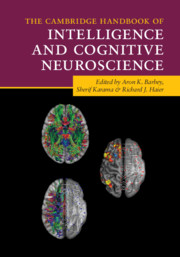Book contents
- The Cambridge Handbook of Intelligence and Cognitive Neuroscience
- Reviews
- The Cambridge Handbook of Intelligence and Cognitive Neuroscience
- Copyright page
- Dedication
- Contents
- Figures
- Tables
- Contributors
- Preface
- Part I Fundamental Issues
- Part II Theories, Models, and Hypotheses
- Part III Neuroimaging Methods and Findings
- Part IV Predictive Modeling Approaches
- Part V Translating Research on the Neuroscience of Intelligence into Action
- 18 Enhancing Cognition
- 19 Patient-Based Approaches to Understanding Intelligence and Problem-Solving
- 20 Implications of Biological Research on Intelligence for Education and Public Policy
- 21 Vertical and Horizontal Levels of Analysis in the Study of Human Intelligence
- 22 How Intelligence Research Can Inform Education and Public Policy
- 23 The Neural Representation of Concrete and Abstract Concepts
- Index
- References
23 - The Neural Representation of Concrete and Abstract Concepts
from Part V - Translating Research on the Neuroscience of Intelligence into Action
Published online by Cambridge University Press: 11 June 2021
- The Cambridge Handbook of Intelligence and Cognitive Neuroscience
- Reviews
- The Cambridge Handbook of Intelligence and Cognitive Neuroscience
- Copyright page
- Dedication
- Contents
- Figures
- Tables
- Contributors
- Preface
- Part I Fundamental Issues
- Part II Theories, Models, and Hypotheses
- Part III Neuroimaging Methods and Findings
- Part IV Predictive Modeling Approaches
- Part V Translating Research on the Neuroscience of Intelligence into Action
- 18 Enhancing Cognition
- 19 Patient-Based Approaches to Understanding Intelligence and Problem-Solving
- 20 Implications of Biological Research on Intelligence for Education and Public Policy
- 21 Vertical and Horizontal Levels of Analysis in the Study of Human Intelligence
- 22 How Intelligence Research Can Inform Education and Public Policy
- 23 The Neural Representation of Concrete and Abstract Concepts
- Index
- References
Summary
Although the study of concept knowledge has long been of interest in psychology and philosophy, it is only in the past two decades that it has been possible to characterize the neural implementation of concept knowledge. With the use of neuroimaging technology, it has become possible to ask previously unanswerable questions about the representation of concepts, such as the semantic composition of a concept in its brain representation. In particular, it has become possible to uncover some of the fundamental dimensions of representation that characterize several important domains of concepts.
Information
- Type
- Chapter
- Information
- Publisher: Cambridge University PressPrint publication year: 2021
